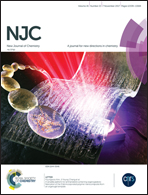A novel iodination-triggered competitive coordination mechanism: indirect detection of Hg2+ and I− using a simple copillar[5]arene-based fluorometric sensor†
Abstract
A novel iodination-triggered competitive coordination has been developed for indirect detection of Hg2+ and I− using the simple copillar[5]arene-based sensor DBP5. While DBP5 could directly sense neither Hg2+ nor I−, the iodinated form of DBP5 detected Hg2+ with high selectivity and sensitivity (3.73 × 10−8 mol L−1). Other cations including Fe3+, Co2+, Ca2+, Ni2+, Pb2+, Cd2+, Zn2+, Cr3+, Mg2+ and Ag+ had no obvious influence on the probing behavior. In addition, a system consisting of Hg2+ in a DBP5 solution highly selectively and sensitively (3.51 × 10−7 mol L−1) detected I− based on a combined iodination and Hg2+ coordination process. It is a novel and efficient way for detection Hg2+ and I− in an aqueous solution. Moreover, the changes in the fluorescence of DBP5 resulting from the addition of Hg2+ and I− were utilized to form a molecular NAND logic gate.
![Graphical abstract: A novel iodination-triggered competitive coordination mechanism: indirect detection of Hg2+ and I− using a simple copillar[5]arene-based fluorometric sensor](/en/Image/Get?imageInfo.ImageType=GA&imageInfo.ImageIdentifier.ManuscriptID=C7NJ01856H&imageInfo.ImageIdentifier.Year=2017)


 Please wait while we load your content...
Please wait while we load your content...